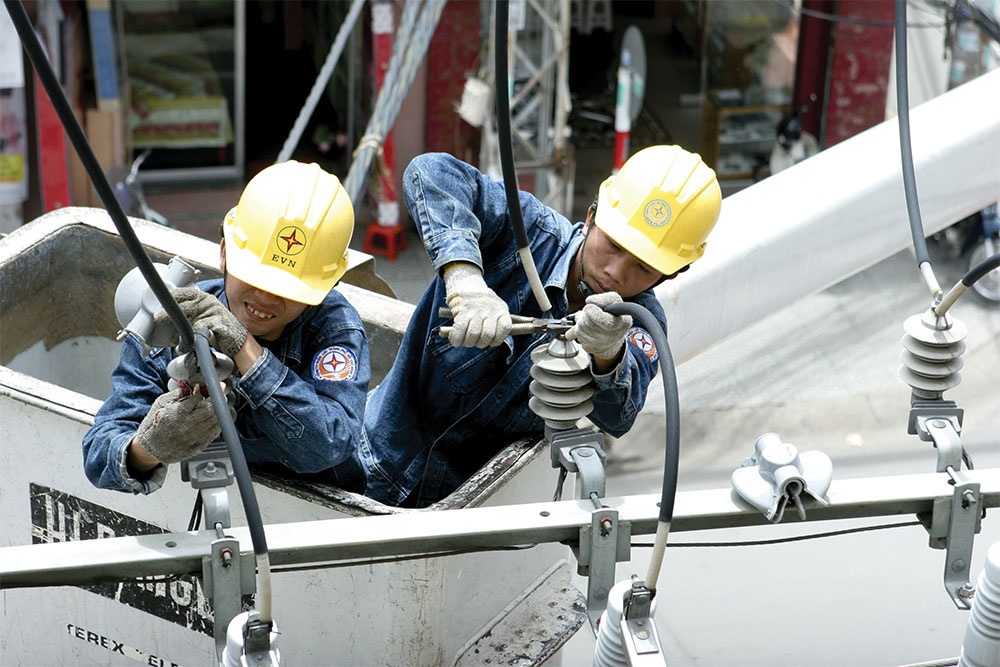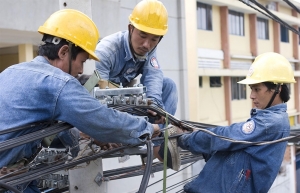Firms ponder impact of new electricity hike
 |
| Some companies have had a plan for some time in case electricity prices were ramped up, photo Le Toan |
Annual inflation in the country has been easing since the beginning of the year, with April consumer prices rising 2.81 per cent from a year earlier. The government is targeting average inflation of 4.5 per cent for the year.
The widely anticipated hike in electricity prices (see box) is expected to help state utility EVN reduce losses as production costs remain elevated. The rise in electricity costs may also thwart the cost-cutting strategies of a number of businesses that are experiencing protracted order shortages.
The increase is significantly less than the price increase scenario previusly devised by Electricity of Vietnam (EVN) and submitted for review by the Ministry of Industry and Trade (MoIT).
General director of Saigon 3 Garment JSC, Pham Xuan Hong, does not wish electricity prices to be raised at this time. “Profits will be negatively impacted if input costs are increased, thereby reducing the competitiveness of products,” he said. For the past few years, Saigon 3 has spent more than $17,000 per month on electricity.
According to Dinh Van Chung, deputy director of Hoa Phat Dung Quat Steel JSC, rising electricity prices have become a “huge burden” for steel producers as orders have not improved and interest rates have surpassed the 10 per cent per annum threshold.
“We have had a plan to minimise the impact of electricity price raises since last year and, at the same time, push investment in technology to recoup excess heat for electricity production, generating roughly 70 per cent of the total required electricity,” Chung said.
Nguyen Tien Thoa, president of the Vietnam Valuation Association, said, “A 3 per cent rise is a modest level and the impact will not be significant on the product prices of manufacturers that use a great deal of electricity.” According to his calculations, the cost of producing steel will increase by 0.18 per cent, cement by 0.45 per cent, and paper by 0.4 per cent.
Electricity manufacturing and company enterprises will continue experiencing issues if the price of electricity only rises modestly, Thoa said. However, the cost of purchasing electricity from coal-fired power plants in 2022 increased by 25 per cent, and from gas turbine plants by 11.3 per cent.
“The large proportion of power generation from thermal power results in greater electricity purchase expenses than the present average retail price computation criteria,” Thoa added.
The MoIT verified at the end of March that the ministry and EVN were not turning away from the proposal of rising electricity prices as a means to rebalance EVN’s finances, given that it suffered losses of over $1.12 billion in 2022, not including the exchange rate deduction of up to $628 million that was not allocated to electricity costs.
According to EVN’s deputy director general Nguyen Xuan Nam, the 3 per cent rise in electricity prices will help boost revenues for the remaining months of this year, estimated at $341 million.
“It will help the group minimise financial difficulties. Residences that produce electricity and pay an average of $450 per month will pay an additional $13 per month after the price of electricity is adjusted,” he said.
In the first four months of 2023, the consumer price index (CPI) increased by only 3.84 per cent compared to the same period the previous year, which is a favourable condition for electricity price adjustment. According to Dr. Bui Trinh, an independent analyst in Haiphong city, the effect of a raise in electricity prices can last through many manufacturing cycles.
“GDP will decline by 0.16 per cent in the next production cycle if businesses are unable to raise product prices and are willing to reduce added value by reducing labour, compensation, or profits,” Trinh said.
Trinh cited information from Vietnam’s intersectoral balance sheet indicating that the production cycle immediately following a 5 per cent rise in electricity prices will increase the CPI by 0.08 per cent and the producer price index by 0.048 per cent.
Increasing electricity prices “have nevertheless introduced a new price range” since output is falling, but Trinh cautions that consumer consumption will be impacted. Currently, consumer demand is feeble due in part to the impact of final consumption demand in 2022, which increased by just 7.8 per cent, while GDP by end-use method grew by 9.6 per cent and GDP by production method increased by 8.02 per cent.
| On April 27, EVN revealed that the average retail price of electricity will be 8.2 cents per kWh from May 4, exclusive of VAT. As announced in February, the average retail price of electricity (excluding VAT) would range 7.8-10 US cents per kWh. In accordance with the new decision, the new price range for retail electricity increases by 0.95-2.3 US cents per kWh compared to the previous average price. |
 | Inflation threat with rising power costs Maintaining control over power prices exerts significant pressure on the electrical business, but rising electricity prices may expose the economy to the hazards of inflation. |
 | Electricity prices to be revised up following holiday The Ministry of Industry and Trade has allowed the Vietnam Electricity (EVN) to revise up electricity prices by a maximum of 3 per cent following the April 30 - May 1 holiday. |
What the stars mean:
★ Poor ★ ★ Promising ★★★ Good ★★★★ Very good ★★★★★ Exceptional
Related Contents
Latest News
More News
- Honda launches electric two-wheeler, expands charging infrastructure (January 12, 2026 | 14:00)
- Vietnam striving to ease air pollution (January 09, 2026 | 14:41)
- Petrovietnam Gas awards first multi‑year LNG deal to Shell (January 09, 2026 | 14:38)
- Advancing the net-zero journey: Carlsberg Vietnam’s sustainability progress in 2025 (January 09, 2026 | 09:49)
- The green hydrogen and ammonia future for Vietnam (January 06, 2026 | 15:03)
- Green transition to close $20 billion annual investment gap (December 31, 2025 | 11:59)
- Australia contributing to Vietnam’s climate change responses (December 30, 2025 | 11:37)
- CME Solar strengthens position in Vietnamese renewables (December 30, 2025 | 11:21)
- Self-care signals shift towards sustainable healthcare (December 30, 2025 | 10:12)
- GreenYellow marks five years of clean energy growth in Vietnam (December 26, 2025 | 15:51)

 Tag:
Tag:



















 Mobile Version
Mobile Version